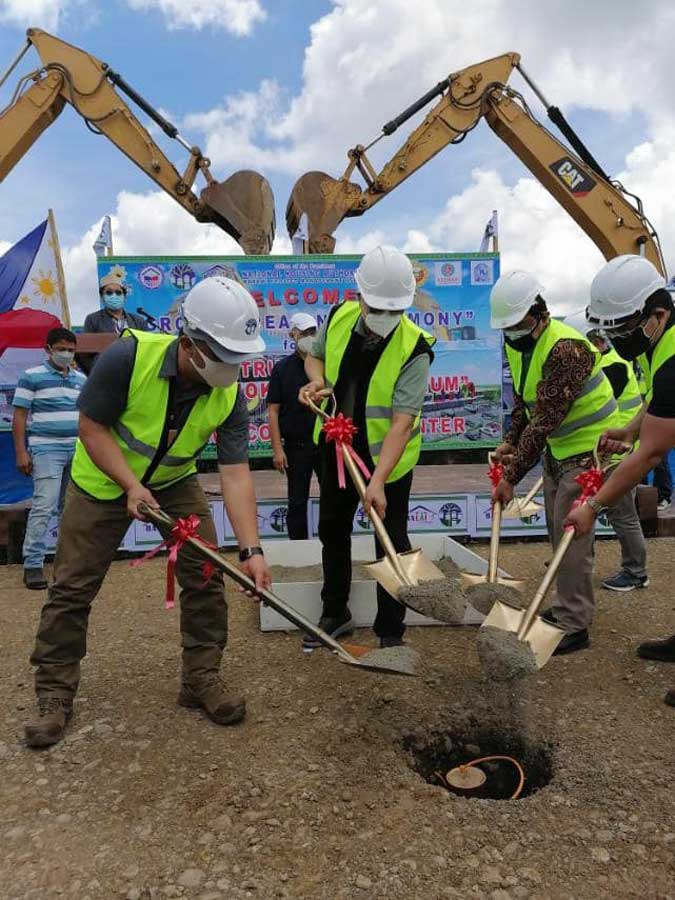DEPARTMENT of Human Settlements and Urban Development (DHSUD) Secretary Eduardo D. Del Rosario, joined by other national and local officials, break ground on May 22 for the Sarimanok Sports Stadium and the Marawi Convention Center which are part of the Marawi rehabilitation program. “These modern infrastructures… are touted to boost tourism and peace-building sports activities,” DHSUD said in its photo release. — DHSUD
OVER P18.69 billion in national government funds — which does not include billions more in donor commitments and money from the regional budget — were spent in the past four years for the recovery of battle-ravaged Marawi City, according to a study by policy research and advocacy center INCITEGov., but deep-rooted wounds linger as displaced residents continue to face uncertainty.
“The first issue has to do with the framework, right now the reality is the only way the people are looking at Marawi is the physical infrastructure when we know that it goes beyond that,” said Maria Carmen Fernandez, researcher of the report Ilang Taong Bakwit: Towards a review of post-Marawi crisis rehabilitation & reconstruction 2017-2020 which will be released in June.
“You have to go beyond physical form and into the different contexts of the crisis,” she said during a forum last Friday hosted by the Foreign Correspondents Association of the Philippines.
The report, intended to provide a systematic assessment of the rehabilitation program, was undertaken with a network of civil society organizations (CSOs) in Marawi.
On the other hand, the government’s task force handling Marawi’s reconstruction also cite CSOs as saying that the achievements of the program are “reason to celebrate” on the fourth-year anniversary of the months-long siege that broke out on May 23, 2017.
That day, government forces were poised to arrest a leader of the criminal group Abu Sayyaf that has pledged ties with the extremist Islamic State. The local terror group laid siege on what is known as the only Islamic City in the Philippines, and the heavy gun battle with government troops stretched to almost five months, leaving the central and outlying areas in ruins.
“We would like to reaffirm that the rehabilitation is doing well,” Faduman Paporo, one of the leaders of CSO Convergence that is monitoring the task force, said in a statement released Friday by the Department of Human Settlements and Urban Development (DHSUD).
The secretary of DHSUD, retired Army general Eduardo D. del Rosario, heads the Marawi task force.
The statement cites ongoing rebuilding projects within the devastated Marawi “ground zero” such as mosques, commercial centers, cultural center and museum, a peace memorial, schools, and health facilities.
The Marawi Advocacy Accompaniment, another network of 21 CSOs in the city and other parts of Mindanao, said reconstruction is not simply about seemingly infrastructure showpieces.
“Rebuilding Marawi should go beyond building large-scale public infrastructures. Rebuilding Marawi is about rebuilding our lives. Rebuilding Marawi should mean rebuilding homes and livelihood necessary for the safe and dignified return of the IDPs (internally displaced persons) to their beloved city,” said the group in a statement after holding a briefing Saturday.
They called on government to prioritize legislation that will address the other aspects of rehabilitation, such as the compensation bill for those whose homes and other properties were destroyed during the 2017 battle.
Housing projects are being rolled out by the government, but Zyza Nadine Suzara, executive director of think tank iLEAD said government reports do not clearly indicate the details of where these are and the resettlement status.
The Institute for Leadership, Empowerment, and Democracy (iLEAD) is part of the team making the INCITEGov report.
Ms. Fernandez said available government data do not reflect the reality on the ground, and that the system does not account for the fact that up to “95% of IDPs” are actually not in evacuation or temporary shelters but are house-based elsewhere.
“How are you going to make moving decisions on the lives of people if the data is not set,” she said.
A wide spectrum of other factors weigh on the rehabilitation program of a city that sits within a historically restive region: clan feuds, land ownership dispute, extremism, underground economy of illicit goods including drugs, a new Bangsamoro government in transition, and the coronavirus pandemic.
“Even the place where the military is going to set up a camp in the middle of Marawi has at least 15 different people claiming ownership… this is the sign of the looming conflicts,” Francisco Lara, senior adviser for International Alert, said in the same forum.
Marawi’s rehabilitation, largely commanded by the national task force, is targeted for completion by December this year, before the campaign and election periods kick in for the national and local polls in May 2022.
Bangsamoro Parliament Member Anna Tarhata S. Basman, one of the vice-chairs of the special committee on Marawi, said extending the transition period for the regional government — not necessarily the incumbent officials — would help provide some stability to what will be the continuing rebuilding and healing of Marawi.
“I agree… that the focus has been on the physical reconstruction and overlooking what the needs and sense of ownership of the IDPs in the entire rehabilitation effort,” she said. — Marifi S. Jara

